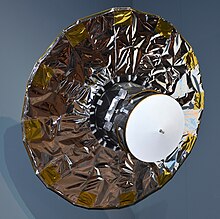Gaia español (Q767805)
Saltar a navegación
Saltar a la gueta
telescopio espacial de la Agencia Espacial Europea español
| Llingua | Etiqueta | Descripción | Tamién llamao |
|---|---|---|---|
| asturianu | Gaia |
Nun ta definida denguna descripción |
|
| inglés | Gaia |
European Space Agency astrometric mission |
|
Declaraciones
Global Astrometric Interferometer for Astrophysics (inglés)
0 referencies
1 referencia
The name ‘GAIA’ was originally derived as an acronym for Global Astrometric Interferometer for Astrophysics. This reflected the optical technique of interferometry that was originally planned for use on the spacecraft. However, the working method has now changed, and although the acronym is no longer applicable, the name Gaia remains to provide continuity with the project. (inglés)
1 referencia
ESA's Hipparcos mission was the first space telescope devoted to measuring stellar positions. Operating from 1989 to 1993, [...]. ESA's Gaia mission is astrometry for the twenty-first century, building on the legacy of Hipparcos [...]. (inglés)
19 avi 2013
1 referencia
vehículo de lanzamiento espacial español
contratista del lanzamiento español
instrumentos científicos a bordo español
Astro español
1 referencia
The main objective of the astrometric instrument (ASTRO) is to obtain accurate measurements of the relative positions of all objects that cross the fields of view of Gaia's two telescopes. (inglés)
29 set 2015
BP/RP español
1 referencia
The photometry function is achieved by means of two low dispersion optics located in the common path of the two telescopes: one for the short wavelengths (BP) and one for the long wavelengths (RP). (inglés)
29 set 2015
RVS español
1 referencia
The primary objective of Gaia's Radial Velocity Spectrometer (RVS) instrument is the acquisition of radial velocities. (inglés)
29 set 2015
señal transmitida español
señal recibida español
periastro español
punto de Lagrange español
tipo de órbita español
periodo orbital español
180 día
3 referencies
potencia consumida español
1910 vatiu
remolcador espacial español
Fregat-MT español
1 referencia
About ten minutes later, after separation of the first three stages, the Fregat upper stage ignited, delivering Gaia into a temporary parking orbit at an altitude of 175 km. (inglés)
Gaia (spacecraft)
0 referencies
Identificadores
identificador COSPAR español
Gaia
Erik Gregersen
0 referencies
SCN español
Enllaces a sitios
Wikipedia(46 entraes)
- afwiki Gaia (ruimtetuig)
- anwiki Gaia (observatorio)
- arwiki غايا (مسبار فضائي)
- azwiki Gaia
- bswiki Gaia (svemirska letjelica)
- cawiki Missió Gaia
- cswiki Gaia (sonda)
- dewiki Gaia (Raumsonde)
- elwiki Γαία (διαστημική αποστολή)
- enwiki Gaia (spacecraft)
- eswiki Gaia (sonda espacial)
- etwiki Gaia (kosmoseteleskoop)
- fawiki گایا (فضاپیما)
- fiwiki Gaia (luotain)
- frwiki Gaia (satellite)
- glwiki Gaia (sonda espacial)
- hewiki טלסקופ החלל גאיה
- huwiki Gaia űrtávcső
- hywiki Գեյա (աստղադիտակ)
- idwiki Gaia (pesawat luar angkasa)
- itwiki Gaia (satellite)
- jawiki ガイア計画
- kowiki 가이아 (우주망원경)
- lawiki Gaia (astronavis)
- lbwiki Gaia (Raumsond)
- ltwiki Gaia misija
- lvwiki Gaia
- mnwiki Гаяа хиймэл дагуул
- mrwiki गाया (दुर्बीण)
- nlwiki Gaia (ruimtetelescoop)
- nnwiki Romteleskopet Gaia
- nowiki Gaia (romsonde)
- plwiki Gaia (sonda kosmiczna)
- ptwiki Gaia (sonda espacial)
- rowiki Gaia (sondă spațială)
- ruwiki Gaia
- simplewiki Gaia (spacecraft)
- siwiki ගායියා (අභ්යාවකාශ යානය)
- slwiki Gaia (vesoljsko plovilo)
- srwiki Свемирска опсерваторија Гаја
- svwiki Gaia (rymdteleskop)
- tawiki கயா (விண்கலம்)
- thwiki ดาวเทียมไกอา
- ukwiki Gaia
- viwiki Gaia (tàu không gian)
- zhwiki 盖亚任务
Wikillibros(0 entraes)
Wikinoticies(0 entraes)
Wikicites(0 entraes)
Wikiesbilla(0 entraes)
Wikiversidá(0 entraes)
Wikivoyage(0 entraes)
Wikcionariu(0 entraes)
Otros sitios(1 entrada)
- commonswiki Category:Gaia (spacecraft)

